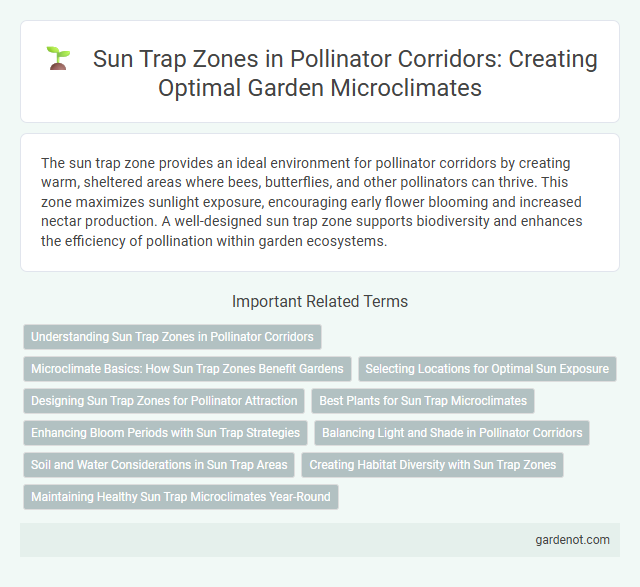The sun trap zone provides an ideal environment for pollinator corridors by creating warm, sheltered areas where bees, butterflies, and other pollinators can thrive. This zone maximizes sunlight exposure, encouraging early flower blooming and increased nectar production. A well-designed sun trap zone supports biodiversity and enhances the efficiency of pollination within garden ecosystems.
Understanding Sun Trap Zones in Pollinator Corridors
Sun trap zones in pollinator corridors are critical areas where sunlight is maximized to enhance flowering plant growth and support pollinator activity. These zones typically feature south-facing slopes or sheltered spots that retain warmth and provide consistent light exposure, promoting early bloom periods and extending foraging opportunities for bees, butterflies, and other pollinators. Understanding the microclimate dynamics of sun trap zones enables the design of corridors that boost biodiversity and improve pollination efficiency in fragmented landscapes.
Microclimate Basics: How Sun Trap Zones Benefit Gardens
Sun trap zones create warm microclimates by capturing and retaining sunlight, which extends the growing season for pollinator-friendly plants in pollinator corridors. These areas increase soil temperature and reduce wind exposure, promoting healthier plant growth and attracting more diverse pollinators like bees and butterflies. Benefits include enhanced nectar production and improved habitat conditions essential for sustaining pollinator populations.
Selecting Locations for Optimal Sun Exposure
Selecting locations for a sun trap zone in a pollinator corridor involves identifying areas that receive direct sunlight for the majority of the day, ideally between 6 to 8 hours. These sun-drenched spots support heat-loving pollinators like butterflies and solitary bees, enhancing their activity and reproductive success. Optimizing sun exposure by avoiding shaded regions beneath tall trees or structures maximizes flowering plant growth and nectar availability, crucial for sustaining diverse pollinator populations.
Designing Sun Trap Zones for Pollinator Attraction
Sun trap zones, designed with south-facing, sheltered areas, create optimal microclimates that maximize warmth and light exposure vital for pollinator activity. Incorporating native flowering plants with staggered bloom times within these zones enhances resource availability for bees, butterflies, and other pollinators throughout the growing season. Strategic placement of organic mulches and windbreaks further supports pollinator health by maintaining soil moisture and reducing environmental stress.
Best Plants for Sun Trap Microclimates
Sun trap zones provide ideal microclimates for heat-loving pollinator plants such as lavender, coneflowers, and black-eyed Susans, which thrive in full sun and improve pollinator diversity. Native species like butterfly weed (Asclepias tuberosa) and goldenrod attract bees and butterflies by offering abundant nectar in these warm, sheltered spots. Incorporating drought-tolerant, sun-loving plants in pollinator corridors enhances habitat connectivity and supports pollinator health in urban and rural environments.
Enhancing Bloom Periods with Sun Trap Strategies
Sun trap zones maximize sunlight exposure by creating sheltered areas that retain warmth, extending the blooming periods of pollinator-friendly plants. These strategies increase floral resource availability during cooler seasons, supporting diverse pollinator populations. Optimizing sun trap microclimates enhances nectar and pollen production, crucial for sustaining pollinator corridors year-round.
Balancing Light and Shade in Pollinator Corridors
Sun trap zones in pollinator corridors create optimal conditions by balancing light and shade to support diverse pollinator species. These microhabitats increase floral resource availability and thermal regulation, enhancing pollinator foraging efficiency and habitat suitability. Integrating sun trap zones promotes biodiversity and ecosystem resilience within pollinator corridors.
Soil and Water Considerations in Sun Trap Areas
Sun trap zones in pollinator corridors require well-drained, nutrient-rich soils to support diverse flowering plants essential for pollinators. Enhancing soil organic matter improves moisture retention and reduces irrigation needs, maintaining a stable microclimate for bees and butterflies. Effective water management techniques, such as mulching and contouring, prevent erosion and maximize water infiltration in these sun-exposed areas.
Creating Habitat Diversity with Sun Trap Zones
Sun trap zones create habitat diversity by providing warm, sheltered microenvironments that support diverse pollinator species. These areas, characterized by south-facing slopes or strategically placed structures, optimize sunlight exposure, enhancing nectar and pollen availability throughout the day. Incorporating sun trap zones into pollinator corridors increases foraging opportunities and fosters resilient ecosystems by accommodating various species with differing thermal preferences.
Maintaining Healthy Sun Trap Microclimates Year-Round
Maintaining healthy sun trap microclimates year-round supports pollinator corridor effectiveness by providing consistent warmth and shelter essential for insect activity and plant growth. These microclimates stabilize temperature fluctuations, enhancing early-season pollinator emergence and extended foraging periods. Optimized sun trap zones contribute to increased biodiversity and resilience within pollinator habitats.
Sun trap zone Infographic

 gardenot.com
gardenot.com